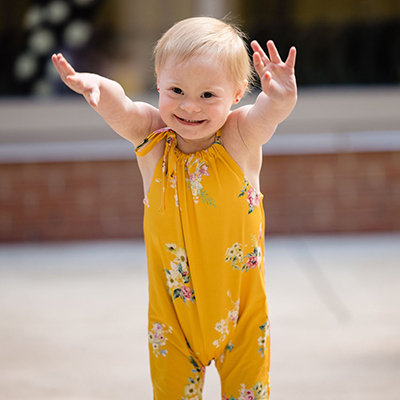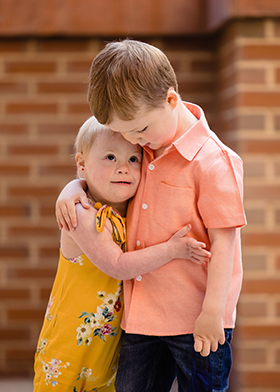Jorie Pucillo
Toddler with Down Syndrome Smiles through Heart Surgery, Chemotherapy
It started as a small, red blotch on her cheek.
 What would normally be a minor nuisance for most kids was a foreboding sign for young Jorie Pucillo. It was the first indication that her blood platelet levels weren’t normal.
What would normally be a minor nuisance for most kids was a foreboding sign for young Jorie Pucillo. It was the first indication that her blood platelet levels weren’t normal.
Doctors had been monitoring Jorie’s platelet levels from birth. As a newborn with Down syndrome, higher levels could mean that she’d become one of the many babies who develop acute lymphocytic leukemia. Babies with Down syndrome are 200 times more likely than other children to develop symptoms of leukemia, typically within the first five years of life.
But the blotch came as a birthday surprise no one wanted for the two-year-old.
Within the span of two days, the red mark grew down her cheek and to the back of her neck. Her face swelled, and she could barely open her eye. When her parents brought her to a hospital in Buffalo, doctors routed her to Golisano Children’s Hospital (GCH) right away. Anxious father Jerry Pucillo followed directly behind the ambulance.
The verdict? A bad case of cellulitis. With some antibiotics and a 10-day hospital stay, Jorie and her father were able to go home. But the red blotch signaled something both parents and doctors had known from the start: the threat of cancer was becoming real.
Start with the Heart
The potential cancer wasn’t the first challenge Jorie had faced in her life thus far, and the first hurdle had come shortly after her mother, Shauna, and father had learned they were expecting twins. While the twins were a welcome surprise, it also meant more testing than the average pregnancy. While her twin brother, Julian, was developing fine, during one of several ultrasounds, doctors discovered an atrioventricular canal defect in the baby that would inevitably grow to become Jorie. If the defect grew bigger, the surgery was likely unavoidable.
Doctors also explained to Shauna and Jerry that many babies with this type of heart condition are born with Down syndrome.
“Ninety percent of kids with Down syndrome have this heart defect,” Jerry said. “Me and my wife are special education teachers so that didn’t even matter to us —we were so worried about the heart. We knew about Golisano, since I was born at Strong, and we knew it was a good hospital.”
Jorie was born on March 21, 2018, in Buffalo, serendipitously on World Down Syndrome Day. She was a little blue compared to her brother, since her heart was working so much harder to pump blood throughout her system. After a stay in the NICU, they supplemented Jorie’s formula with extra calories to make up for the ones her body was burning through due to her heart problem.
At six months old, Jorie had open heart surgery at Strong with George Alfieris, M.D. Her parents were understandably worried, but were put at ease by Alfieris’s calming words.
“He came in and he was like, ‘I’m going to treat her like my own daughter. I’ve done this surgery as many times as you’ve brushed your teeth,’” Jerry said. “It made us feel a lot better.”
The surgery went off without a hitch and, while Jorie still has a slight heart murmur, there’s little concern over that becoming an issue in the future.
However, during her recovery, she experienced a cold and pulmonary hypertension. Although the cold went away, the hypertension persisted. Jorie’s care team, which included oncologist Craig Mullen, M.D., Ph.D., monitored her blood counts, which had been atypical since the day she was born. And then came the red blotch on her face. Together, these signs suggested the early stages of myelodysplasia (MDS), a condition that could eventually grow into acute lymphocytic leukemia.
“We knew she might develop leukemia this whole time,” Jerry said. “We said, ‘it’s a year and a half later, let’s go talk to Mullen about the cancer.'”
Treating the Cancer
As Jorie’s oncologist, Mullen was well acquainted with her case. He had been monitoring her blood counts and bone marrow biopsies since she was around a year old.“
Leukemia typically appears in the first five years out of the blue, but it can also occur at birth when abnormal blood counts suggest something is going on,” Mullen said. “This is what happened in Jorie’s case.”
Jorie was put on a chemotherapy regimen to help stop MDS in its tracks. In conjunction with the Children’s Oncology Group —the largest North American childhood cancer organization —Mullen enrolled Jorie in a study that focused on leukemia and Down syndrome.
Children with Down syndrome either have a good experience or a bad experience with chemotherapy, Mullen explained. When the right dose is struck, they respond very well to treatment. When the right dose isn’t found quickly, however, it can be especially difficult for the child to handle.
“Toxicity pushes down healthy blood counts. While we’re whacking the bad blood, we’re also whacking the healthy blood,” Mullen said. “There’s a big risk of severe, overwhelming infection. We can’t infuse infection-fighting cells. We can’t give another cycle of chemo until the red blood cell count returns to healthy levels.”
In Jorie’s case, the first cycle of her chemotherapy regimen stuck. This meant they could continue with less-intense chemotherapy options instead of upping the dose. Mullen decided on a standard regimen: administering six cycles of chemo over an eight-month period.
These cycles consisted of five to seven days of chemotherapy followed by a stay in the hospital. This ensured that the doctors were able to monitor Jorie for complications. But it wasn’t only medically demanding; it was also socially demanding.
Jorie was brought to GCH for her cancer treatment at the start of the COVID pandemic. That meant her parents would have to stay with her in the hospital for weeks at a time out of fear of catching or spreading the virus.
“It was crazy because that’s when things started locking down for COVID,” Jerry said.
“I was in there for 30 days straight —I couldn’t leave her.”
COVID posed an enormous challenge to the family, but it was also difficult being away from each other for so long.
“I barely saw my wife, but we had to do what we had to do,” Jerry said. “Being separated for so long was the hard part. I missed the boys (Julian, and Jorie’s older brother, Anthony) so much. It was rough.”
Luckily, Jerry’s parents live in Rochester, making it easier to navigate home and family life. Jerry and Shauna took turns with Jorie so that he was able to see the boys on the weekends. When he stayed with Jorie throughout the week, he was able to work remotely from the hospital room.
Their efforts were rewarded: overall, Jorie did well on chemotherapy. Besides a couple of skin reactions, Jorie stayed cheerful and smiling more often than not, even through the many platelet transfusions she needed to support her health.
Recovery and Remission

On March 29, 2021, Jorie came back to GCH for a bone marrow biopsy. The test would reveal if her cancer was reacting to the treatment and whether or not they would need to continue chemo in the future.
The result? Jorie’s cancer is officially in remission.
“Since completing chemo, things are going well,” Mullen explained. “She’s remaining in remission. We’re keeping our eyes open for relapse, where the greatest risk is in the first couple of years. Now, she’s doing all the things she does as a three-year-old. Interacts with family, school etc. She’s a delightful little kid, and I’m hoping for the best in the future.”
It’s the hard work of her loving parents, the outstanding compassion of the doctors, nurses and staff at GCH and Jorie’s own optimism that has enabled her to come this far. Even when she was struggling in the hospital, Jorie still greeted each day with a smile. Whenever the care team came into the room to assess her health, Jorie adopted the habit of giving every single one of them a fist bump.
“Jorie was always cheerful and playful and interactive,” Mullen said. “There’s something special about people with Down syndrome. They have a sunny disposition and live in the here and now. Kids with Down syndrome are God’s reminder that the day is good.”
Looking back on the experience, Jerry admits it was hard to go through, but he realizes how lucky they are.
“Other families have it so much worse,” he said. “I ran into someone I knew and her daughter is going through a different type of leukemia. When you see other families it can put things into perspective. There are kids who don’t make it. It’s hard to wrap your head around.”
Jerry is thankful for all the hard work performed by the hospital, so much so that he wanted to give back. “The whole experience has shined light on how people care,” Jerry said. “The nurses and staff —everyone involved loved my daughter. You don’t expect that. Even the residents, the music therapy team, the people that came to clean my rooms —they were all amazing.
”During Jorie’s treatment, Jerry started a fundraising campaign selling t-shirts in Jorie’s honor. He designed a logo infusing the various aspects of Jorie’s health journey: there’s a golden ribbon for her childhood leukemia, a heart for her heart surgery, and three arrows for her Down syndrome. The campaign was wildly successful and the family has raised more than $12,000 for GCH to date.
“It was awesome to have that support,” he said. “It kind of gave a sense of belonging when you’re living out of a suitcase and sleeping on a cot. That’s why I wanted to raise that money and do what I could to help them.”
Jorie will continue to get routine biopsies to ensure that her cancer remains in remission. While the journey seemed long at the time, Jerry recognizes how far they’ve come.
“There were bad days,” Jerry said. “But most of the time? She was happy. I got inspiration from my daughter who’s two and who’s so strong and resilient that nothing brought her down."